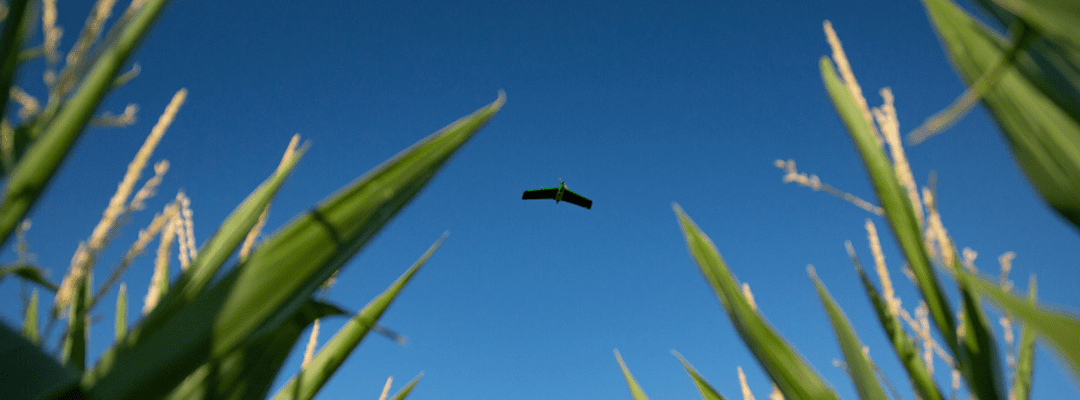It’s a bird, it’s a plane… no, it’s a fixed wing drone (is that how the saying goes?).
Built like miniature airplanes, fixed wing drones have been taking over the skies as they become more and more popular within the drone industry.
With the goal of more efficient and effective mapping capabilities and data capture, drones’ adoption has grown significantly in agriculture, construction, environmental, and many other industries. And with the differing needs on a case-to-case basis, there have been various types of drones that have come to market including:
- Single rotor drones
- Multirotor drones
- Fixed wing drones
- Fixed wing hybrid vertical takeoff and landing (VTOL) drones
Choosing Which Drone to Use and When
Like other equipment, the different types of drones specialize in unique situations and circumstances. But which drone type meets your goals and guidelines? Some questions to consider when choosing the ag drone that is best suited for your needs are:
- How many acres are you covering?
- How much flight experience do you have?
- Are there many obstacles in your fields?
- What type of data are you trying to capture?
- How fast do you need to collect this data?
While these questions only scratch the surface of what determines the drone system that’s ideal for your wants and needs, it is a good foundation for drone selection.
Single and multirotor drones are known for their maneuverability; however, they’re not ideal for large-scale operations due to reduced endurance. And vice versa for fixed wing drones: they do better on large, open fields rather than smaller, obstacle ridden areas.
Large field-scale operations that would otherwise take hours or days with boots-on-the-ground scouting, or even with smaller drones, are where autonomous fixed wing drones are optimal. Typically, fixed wing drones best fit larger operations due to their higher endurance and ability to cover more acres per battery. This allows fixed wing drones to cover more acres, and multiple fields within datalink range much faster than other methods.
Factors that Differential Fixed Wing Drones from Others
Fixed wing drones are different from other drone types, from their takeoff to landing. Fixed wing drones takeoff more like a traditional airplane, but without the need for a runway. Instead of a vertical takeoff from the ground up (like seen with rotor drones), fixed wing drones require the user to physically launch – or throw – the drone into the air. This requires a certain speed that needs to be reached for the drone to be successfully launched. Whether it’s with the help of wind or the power in which you horizontally launch them, this momentum ensures successful takeoff and begin its climb to the optimal altitude.
First and foremost, fixed wing drones are built in a unique way compared to single and multirotor drones and mirror that of an airplane. This shape is engineered to maximize flight performance by enhancing the drone’s endurance and providing more stability. The added aerodynamic stability of their structure allows them to better withstand windy conditions.
The increased range and extended flight time of fixed wing drones separates them from other UAVs. A fixed wing drone is known for covering more acres per battery, enhancing efficiency in data collection for larger operations.
Like with takeoff, landing a fixed wing drone is rather different than other drones; often requiring slightly more consideration or planning. This is one of the differentiating factors of Sentera’s PHX and other commercial fixed wing drones. The PHX, for example, cuts the motor at a lower altitude. This means the aircraft follows its trajectory, taking advantage of its control authority. As a result, it is more resilient to winds and lands more consistently.
The Result: Covering More Acres, Faster
Fixed wing drones have a significant productivity advantage in large scale operations due to their ability to cover more ground faster. When you’re covering more acres more efficiently, you’re getting timelier insights into field performance. Multirotor drones simply can’t keep up with fixed wing drones in terms of productivity and efficiency. And, it doesn’t stop there – it can result in some significant productivity gains as well. With Sentera’s PHX combined with the Double 4K Sensor, one grower even made an extra $50,000 on a 150-acre field.
Why is this? Fixed-wing drones are more aerodynamic and can fly at higher speeds. Additionally, fixed-wing drones typically have longer battery lives than multi-rotor drones, which allows them to stay in the air for longer periods of time.
For these reasons, fixed-wing drones are ideal for applications where large areas need to be covered quickly, such as in agriculture, surveying, and disaster relief. For example, a fixed-wing drone can be used to map more acreage in an hour while a multi-rotor drone would take several hours to complete the same task. Overall, fixed-wing drones are the best choice for applications where large areas need to be covered quickly and efficiently.
As fixed-wing drone technology continues to develop, users can expect to see even more innovative and efficient ways to use these drones to cover large areas quickly.


